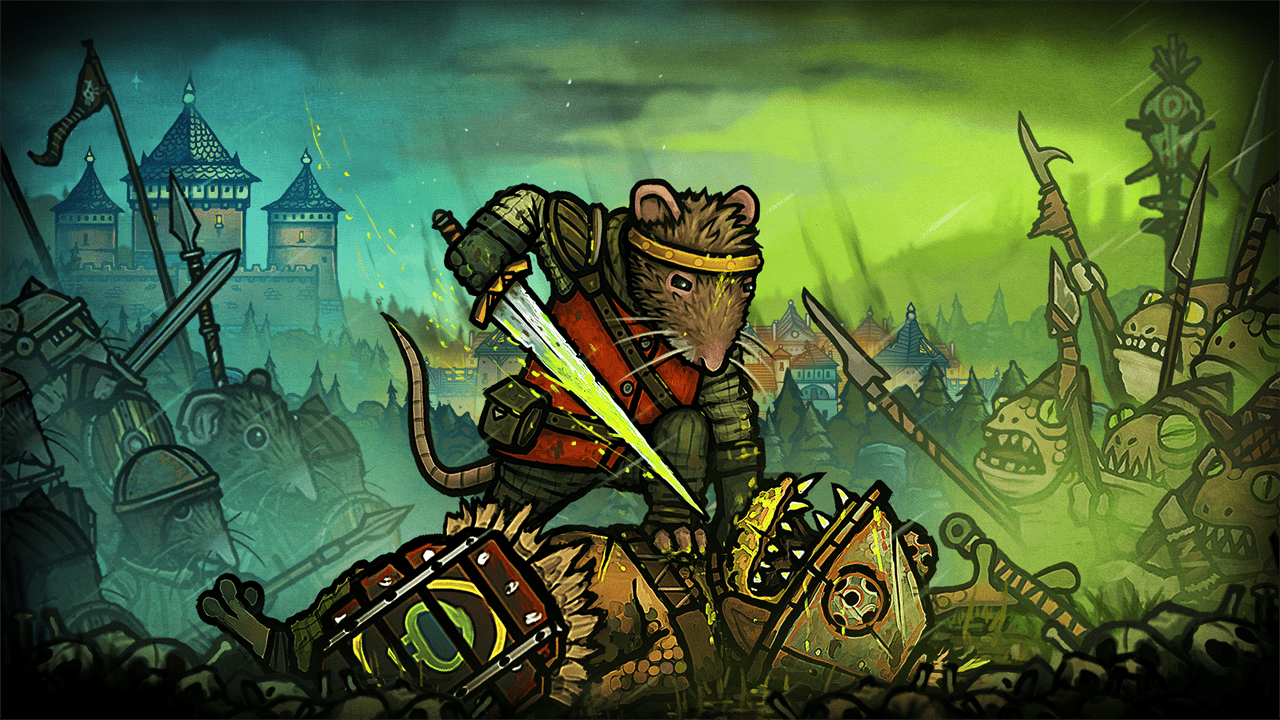A gorgeous, enormously charming 2D aRPG, Tails of Iron is a challenging and deeply rewarding soulslike game. The Finger Guns Review.
I can see the armoured frog enemies up ahead, gathered around a camp fire. There’s a few of them. This is going to be tough. I venture forth and the amphibian warriors finally see me, turn and yell out their battle call. It’s go time. A frog with a nailed club comes at me first. A quick dodge and I’m in behind it. Attack, attack, attack with my little rat spear. It’s down. Now it’s 2 shield wielding frogs coming from either side. They attack one after another. Dodge, dodge roll and I can attack again – only I failed to see the trident carrying frog enter from the far right. It stabs me with a basic attack and immediately follows up with a running attack that I’m too slow to parry. I’m down and I’m hurting. There’s barely a figment of my health bar left. My fingers kick into over drive, stabbing, dodging and parrying all 3 frogs as they attack from all directions. 1 down. 2 down. 3 down. I take a deep breath to survey my handwork as a frog enters from the left and looses an arrow that flies across the screen. Thud.
You Died. A familiar message covers the screen. I load back up at the generous save point shortly before this fight. We go again.
I’d be frustrated but I’m too busy smiling. Tails of Iron is filled with exhilarating moments like this that pose a real challenge but are always surmountable with enough concentration and patience, and maybe a little bit of luck. Tails of Iron can affectionately be called a Soulslike despite it looking nothing like the genre staples. Combining a metroidvania structure with an RPG loot system, combat that’s challenging but with readable tells to learn and exploit, it ticks all of the sub-genre’s tick boxes. Unlike many Soulslikes though, Tails of Iron comes with an arresting amount of charm and a heart felt story. Combined, it makes for a heady blend which is easily one of my favourite games of 2021.
A story primer: The frogs and the rats had been at war with one another for years with neither side managing to make ground on the other. That was until the rat king rose, united all of rat-kind under his banner and forced the frogs, lead by the fearsome Greenwart, hopping back to their swamps. Finally, there was peace across the land.
That was years ago now and the king had grown old. This is where we begin with Tails of Iron. The game follows the adventure of Redgi, the smallest of the rat king’s children. The little-rat-that-could proves to his father that he’s the rightful heir to the throne by defeating his big, burly brother in combat. Just as he’s about to be coroneted, the frogs return with a vengeance. Greenwart and his army trash the crimson keep, massacre the rat forces and leave Redgi to die. Only he survives. Among the ruins of the once glorious rat throne room, Redgi sets out on a quest to rescue any family and friends that survived the invasion and hopefully take the fight to the frogs.
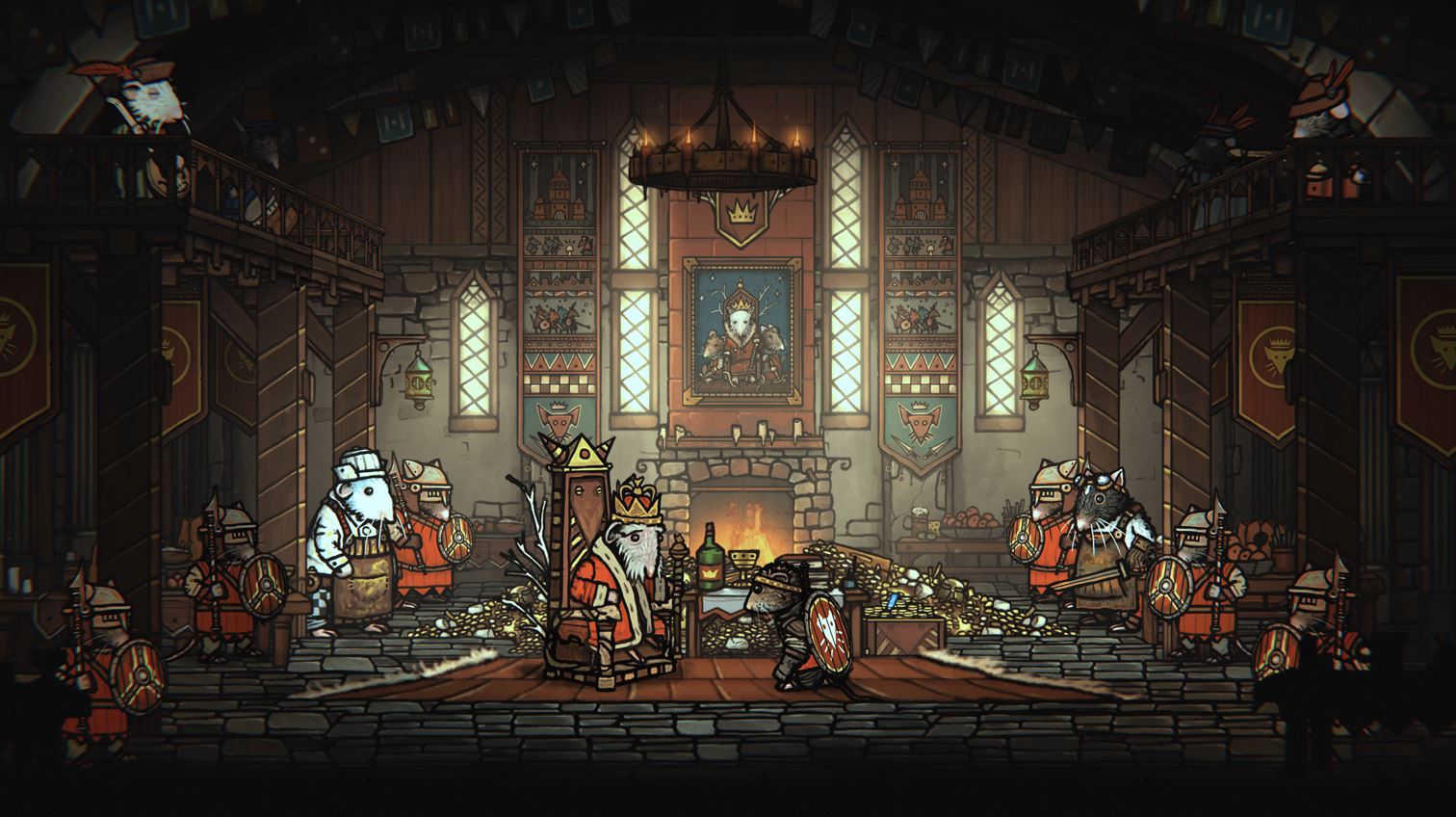
The plot setup to Tails of Iron works incredibly well. You begin by exploring a flourishing rat kingdom only to see it decimated by a villain you immediately want to take revenge on. Like playing as a losing contestant on Bullseye, you get to see what you could have won – a gorgeous kingdom, supportive and helpful friends and siblings, a crown and throne – only for a giant, violent frog version of Jim Bowen to arrive and say “Now take it away”. It’s a motivation that’s regularly reinforced throughout the game as you play as a young king that regularly finds his subjects under threat and his realm destroyed by the invading forces. It really drives you forward at each new stop along the way.
This is all brought to life by narration from Doug Cockle, whom you might recognise as Geralt of Rivia from The Witcher games. His rich, gruff voice complements the tone of Tails of Iron perfectly. It also acts as excellent juxtaposition to the charming way that the rats communicate to one another too; As the rats talk, little speech bubbles appear above their heads containing story images which are accompanied by the chirping sound of a slide whistle (or maybe a flute? Musical instruments aren’t my forte). Each and every time a pair of rats communicate, it’s oh so endearing, but it’s not always immediately clear what the next objective is. The frankly excellent script, which is informative, directive yet witty, helps fill in the gaps via Cockle’s high quality delivery.
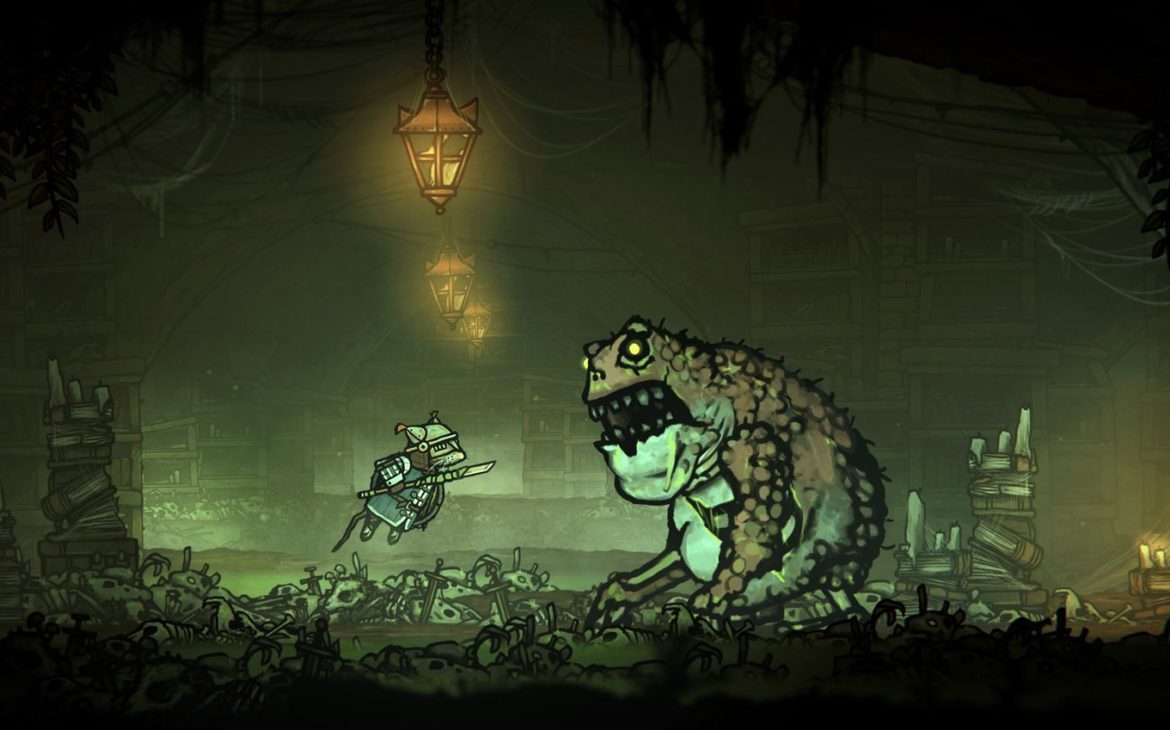
Tail of Iron’s structure and progression path certainly falls in line with your standard Metroidvania system. Redgi will get an objective – either main or side quest – and will then set off to achieve said aim. This could be to reach a certain waypoint, defeat a band of foes or to collect certain items. The game is made up of linked screens that can all be tracked via an easy to read map that can be called up at any time with a click of a button. As you progress through the game, you’ll unlock new weapons, abilities and meet new characters which in turn will unlock paths that were previously barred. Within each environment, you’ll find some light platforming, the occasional pitfall (there’s fall damage here), characters to chat with, secrets to find and adversaries to vanquish.
The combat in Tails of Iron is its biggest strength. There’s an impressive variety of enemies to engage with from shielded frogs, agile mosquitos, rock throwing grubs, technologically advanced moles and even zombies, all of which have their own set of strengths and weaknesses. To put it bluntly – Tails of Iron can be really challenging at times. Any encounter, even 1 on 1’s with the weakest of frogs, can result in a “You Died” screen if you’re not paying attention. Redgi is rarely larger or outright more deadly that the enemies he faces, so he has to out finesse his opponents rather than overpower them. The trick here is that every enemy offensive manoeuvre is telegraphed to the player via 1 of 4 symbols shortly before they attack. Redgi has a reply to each of these – blocking for white ranged attacks, dodging a red standard attack, parrying yellow attacks and avoiding red bubble attacks entirely with dodge rolls – which, if pulled off, will open up a window for him to reply with his own strikes. As you progress through the game, you’ll gain new weaponry types too which can open up their own windows to deal damage. For example, when you get hold of a two-handed weapon, a charged attack can knock back shield bearers to make them vulnerable for a few seconds.
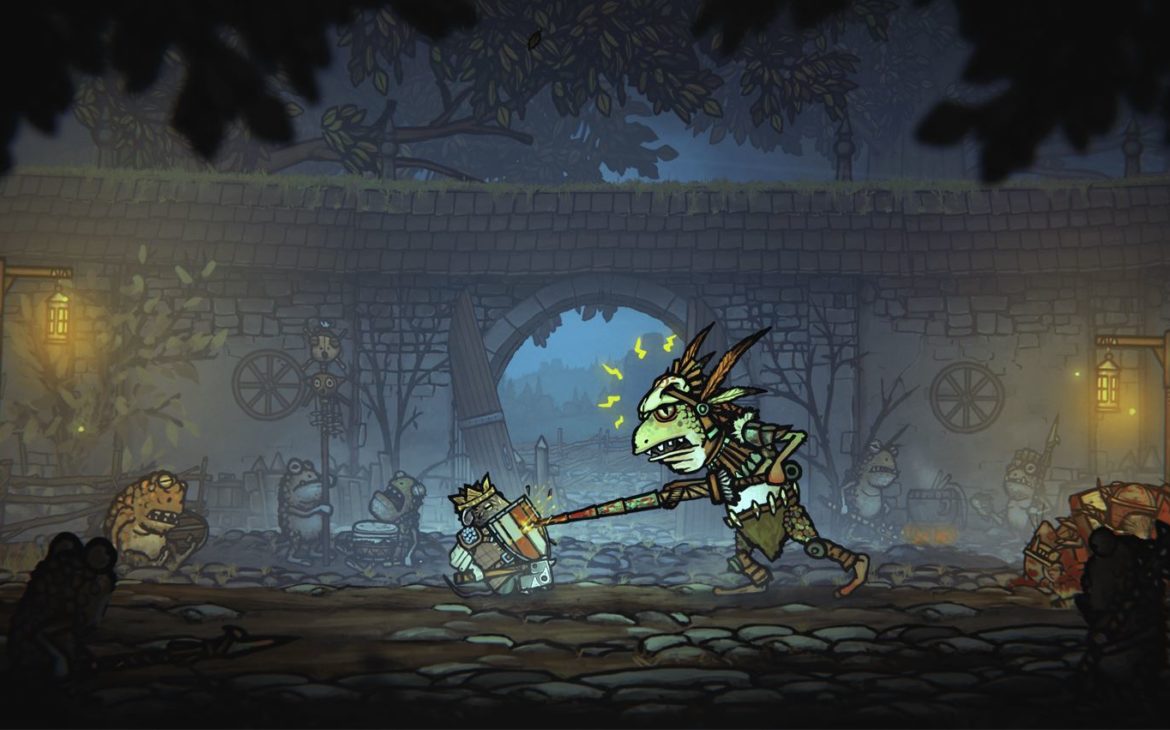
While the combat in Tails of Iron is challenging, it’s also fair. There wasn’t a single moment during the game where I felt like a death was cheap. Failures were mine alone and not because of some hidden enemy that jumped out of the scenery. This is certainly helped by a very well managed difficulty curve. You’ll usually come face to face with an enemy type for the first time when they’re alone. This gives you ample time to learn their attack patterns before they turn up in greater number and mixed in with waves of enemies later on in the game.
The fact that the combat in Tails of Iron can be quite formidable means that it’s also oh so satisfying when you overcome its tougher moments. During boss fights, this is punctuated by fatality like animations, available once the majority of their health bar has been deplete, which can be triggered with a click of the right stick. This is where Redgi really gets to stick the boot in and it’s never not immensely gratifying. I’ll be honest, there have been a few moments where I’ve jumped up off the couch and celebrated like I’ve just watched my beloved Stoke City FC score a goal (it’s a rarity, so we celebrate every one of them) before settling down to loot the corpse of my now vanquished foe for any goodies they were holding.
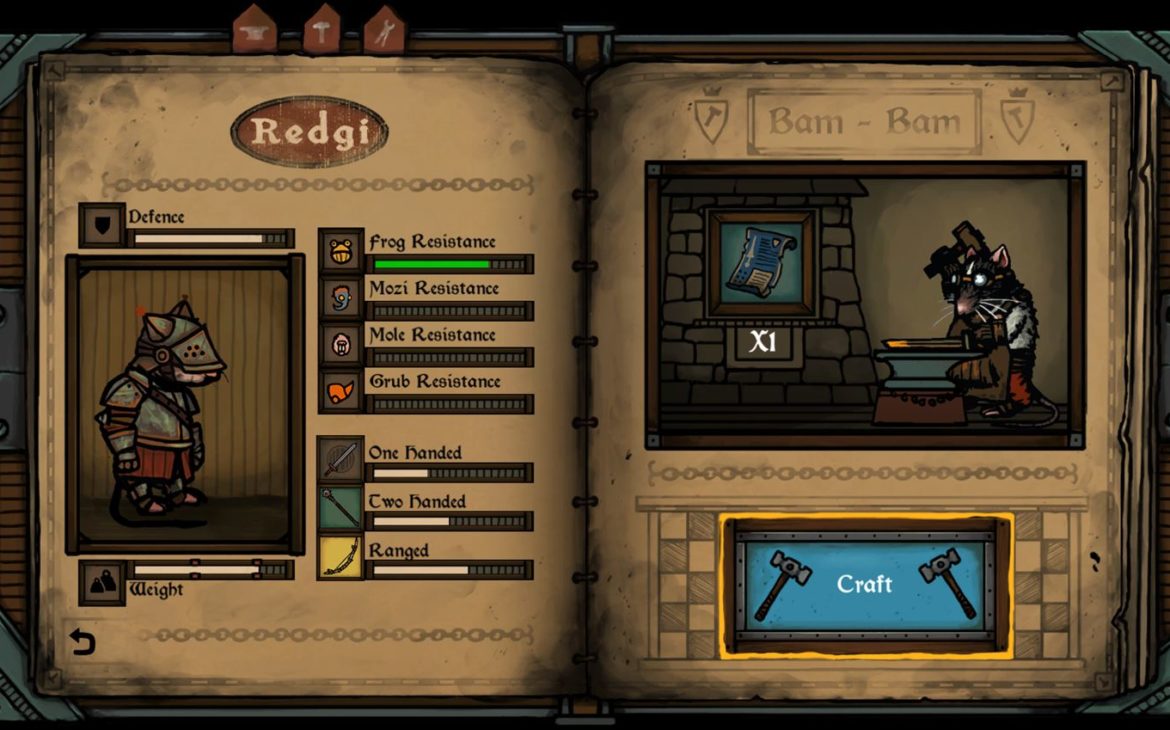
If there’s one thing I’d change about the combat in Tails of Iron, it’s the fact that the screen becomes black and white for a short time when Redgi’s health bar gets dangerously close to empty. I understand why this is an aspect of the game – it’s an immediate visual cue that you’re in dire trouble and also elevates the tension of the fight – but it’s counter intuitive when your attack prompts from an enemy are colour coded. When an enemy has the capability to dish out all 4 types of attack, it’s difficult to differentiate them in the heat of battle when they’re all presented in black and white. To solve this, it’d make sense to have the attack symbols retain their colour even when the rest of the screen becomes monotone. It’s a small thing, but it’s worth mentioning.
The weaponry and armour make up the RPG-lite element of Tails of Iron. As you travel through the lands, defeating bosses and meeting new characters, you’ll find new items that can be equipped immediately, or sent to an equipment box to be used later. There’s no complex number systems used here; The menu system is really intuitive, using gauges with red or green indicators to show the effect that equipping a new piece of armour or weapon will have. After the midpoint in the game, you’ll also have to start worrying about the amount of weight Redgi is carrying. That charming little rat isn’t built like a tank and can only carry so much so you’ll have to make judgement calls on what equipment he’ll take forward.
A personal bugbear with Metroidvanias is backtracking. It’s the nature of the beast I suppose, having to slog through previously explored areas to unlock a new path forward, but even that’s less onerous than the usual standard in Tails of Iron. That’s because the world itself responds to Redgi’s progress. Fighting your way through a town and defeating the foes that wait at the end of it will result in life returning to the area. Quiet, rain slick streets make way for musicians and gathered crowds. Empty encampments start to fill with friendly forces once again. It’s one of many little touches that make this game world so arrestingly charming.
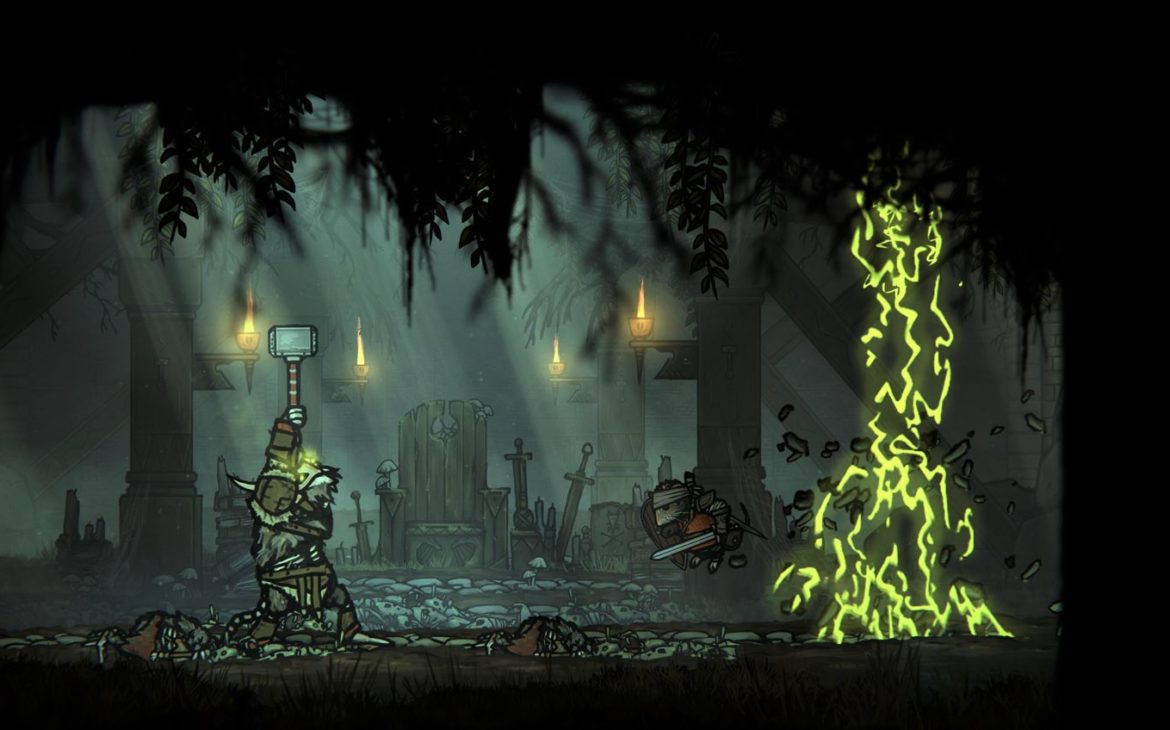
The primary reason that Tails of Iron is so charming though is because of its frankly gorgeous art style. Like a playable hand painted pop-up book, the world has layers of water coloured depth that pan behind you which make for a persistently charismatic environment to explore. This is an evolution of the trademark art style that Odd Bug Studio coined with their previous title The Lost Bear, developing it into something truly beautiful and unique. I dread to imagine the number of hours that have been put into crafting the art work for this game but it’s hard to argue with the end result. It’s stunning. The same can be said about the music which carries the tone of each scene, adding tension to battle and impact to the stories poignant moments.
There’s a hand full of tiny niggles with Tails of Iron, like pieces of scenery occasionally blocking the view during combat, but they do very little to sour a game that is, in my estimation, one of the best games of 2021 so far. When I first saw this game several years ago, sat on a bench outside of EGX, it looked very promising. In that intervening time, Tails of Iron has fulfilled all of that potential and become something quite special. It’s one of the easiest recommendations I’ll make this year.
An exhilarating 2D soulslike set in a remarkably charming world, Tails of Iron is a surprise GOTY candidate. You’ll croak and die often due to the formidable combat but the narrative and systems will keep you coming back for more, like a rat does to cheese.

Tails of Iron is available Nintendo Switch, PlayStation 4, PC via Steam, PlayStation 5, Xbox Series X and Series S (review platform) and Xbox One.
Developer: Odd Bug Studio
Publisher: United Label
Disclaimer: In order to complete this review, we were provided with a promotional copy of the game. For our full review policy, please go here.
If you enjoyed this article or any more of our content, please consider our Patreon.
Make sure to follow Finger Guns on our social channels –Twitter, Facebook, Twitch, Spotify or Apple Podcasts – to keep up to date on our news, reviews and features.
